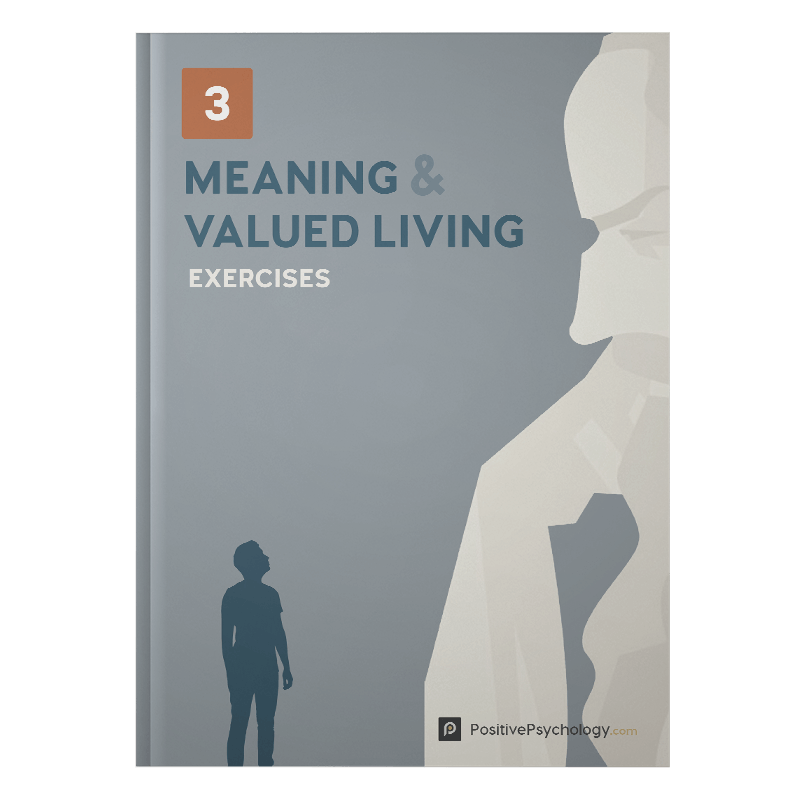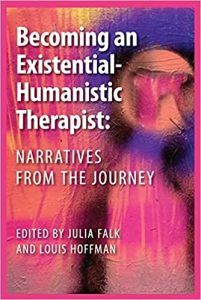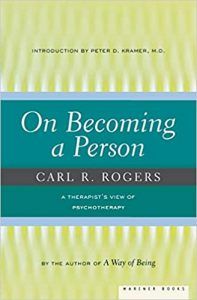Humanistic Psychology’s Approach to Wellbeing: 3 Theories
 Despite what the media may depict, people are innately good.
Despite what the media may depict, people are innately good.
That sounds quite nice, doesn’t it? Let’s repeat that again.
Humans are innately good.
Driving forces, such as morality, ethical values, and good intentions, influence behavior, while deviations from natural tendencies may result from adverse social or psychological experiences, according to the premise of humanistic psychology.
What does it mean to flourish as a human being? Why is it important to achieve self-actualization? And what is humanistic psychology, anyway?
Humanistic psychology has the power to provide individuals with self-actualization, dignity, and worth. Let’s see how that works in this article.
Before you continue, we thought you might like to download our three Meaning and Valued Living Exercises for free. These creative, science-based exercises will help you learn more about your values, motivations, and goals and will give you the tools to inspire a sense of meaning in the lives of your clients, students, or employees.
This Article Contains:
- What Is the Humanistic Psychology Approach?
- Brief History of Humanistic Psychology
- 10 Real-Life Examples in Therapy & Education
- Popular Humanistic Theories of Wellbeing
- Humanistic Psychology and Positive Psychology
- 4 Techniques for Humanistic Therapists
- 4 Common Criticisms of Humanistic Psychology
- Fascinating Books on the Topic
- More Resources From PositivePsychology.com
- A Take-Home Message
- References
What Is the Humanistic Psychology Approach?
Humanistic psychology is a holistic approach in psychology that focuses on the whole person. Humanists believe that a person is “in the process of becoming,” which places the conscious human experience as the nucleus of psychological establishment.
Humanistic psychology was developed to address the deficiencies of psychoanalysis, psychodynamic theory, and behaviorism. The foundation for this movement is understanding behavior by means of human experience.
This entity of psychology takes a phenomenological stance, where personality is studied from an individual’s subjective point of view.
Key focus of humanistic psychology
The tenets of humanistic psychology, which are also shared at their most basic level with transpersonal and existential psychology, include:
- Humans cannot be viewed as the sum of their parts or reduced to functions/parts.
- Humans exist in a unique human context and cosmic ecology.
- Human beings are conscious and are aware of their awareness.
- Humans have a responsibility because of their ability to choose.
- Humans search for meaning, value, and creativity besides aiming for goals and being intentional in causing future events (Aanstoos et al., 2000).
In sum, the focus of humanistic psychology is on the person and their search for self-actualization.
Brief History of Humanistic Psychology

At this time, humanistic psychology was considered the third force in academic psychology and viewed as the guide for the human potential movement (Taylor, 1999).
The separation of humanistic psychology as its own category was known as Division 32. Division 32 was led by Amedeo Giorgi, who “criticized experimental psychology’s reductionism, and argued for a phenomenologically based methodology that could support a more authentically human science of psychology” (Aanstoos et al., 2000, p. 6).
The Humanistic Psychology Division (32) of the American Psychological Association was founded in September 1971 (Khan & Jahan, 2012). Humanistic psychology had not fully emerged until after the radical behaviorism era; however, we can trace its roots back to the philosophies of Edmund Husserl and Martin Heidegger.
Husserl spurred the phenomenological movement and suggested that theoretical assumptions be set aside, and philosophers and scientists should instead describe immediate experiences of phenomena (Schneider et al., 2015).
Who founded humanistic psychology?
The first phase of humanistic psychology, which covered the period between 1960 to 1980, was largely driven by Maslow’s agenda for positive psychology. It articulated a view of the human being as irreducible to parts, needing connection, meaning, and creativity (Khan & Jahan, 2012).
The original theorists of humanistic theories included Abraham Maslow, Carl Rogers, and Rollo May, who postulated that behaviorism and psychoanalysis were inadequate in explaining human nature (Schneider et al., 2015).
Prior to these researchers, Allport, Murray, and Murphy had protested the reductionist movement, including the white laboratory rat as a method for comparing human behavior (Schneider et al., 2015). Influential women in the development of this branch of psychology included Frieden and Criswell (Serlin & Criswell, 2014).
Carl Rogers’s work
Carl Rogers developed the concept of client-centered therapy, which has been widely used for over 40 years (Carter, 2013). This type of therapy encourages the patient toward self-actualization through acceptance and empathetic listening by the therapist. This perspective asserts that a person is fully developed if their self is aligned with their organism (Robbins, 2008).
In other words, a fully functioning person is someone who is self-actualized. This concept is important, as it presents the need for therapy as a total experience.
Rogers’s contribution assisted the effectiveness of person-centered therapy through his facilitation of clients reaching self-actualization and fully functional living. In doing so, Rogers focused on presence, congruence, and acceptance by the therapist (Aanstoos et al., 2000).
The Humanistic Theory by Carl Rogers – Mister Simplify
10 Real-Life Examples in Therapy & Education
The human mind is not just reactive; it is reflective, creative, generative, and proactive (Bandura, 2001). With this being said, humanistic psychology has made major impacts in therapeutic and educational settings.
Humanistic psychology in therapy
The humanistic, holistic perspective on psychological development and self-actualization provides the foundation for individual and family counseling (Khan & Jahan, 2012). Humanistic therapies are beneficial because they are longer, place more focus on the client, and focus on the present (Waterman, 2013).
Maslow and Rogers were at the forefront of delivering client-centered therapy as they differentiated between self-concept as understanding oneself, society’s perception of themselves, and actual self. This humanistic psychological approach provides another method for psychological healing and is viewed as a more positive form of psychology. Rogers “emphasized the personality’s innate drive toward achieving its full potential” (McDonald & Wearing, 2013, p. 42–43).
Other types of humanistic-based therapies include:
- Logotherapy is a therapeutic approach aimed at helping individuals find the meaning of life. This technique was created by Victor Frankl, who posited that to live a meaningful life, humans need a reason to live (Melton & Schulenberg, 2008).
- Gestalt Therapy’s primary aim is to restore the wholeness of the experience of the person, which may include bodily feelings, movements, emotions, and the ability to creatively adjust to environmental conditions. This type of therapy is tasked with providing the client with awareness and awareness tools (Yontef & Jacobs, 2005). This includes the use of re-enactments and role-play by empowering awareness in the present moment.
- Existential Therapy aims to aid clients in accepting and overcoming the existential fears inherent in being human. Clients are guided in learning to take responsibility for their own choices. Rather than explaining the human predicament, existential therapy techniques involve exploring and describing the conflict.
- Narrative Therapy is goal directed, with change being achieved by exploring how language is used to construct and maintain problems. The method involves the client’s narrative interpretation of their experience in the world (Etchison & Kleist, 2000).
Humanistic psychology has developed a variety of research methodologies and practice models focused on facilitating the development and transformation of individuals, groups, and organizations (Resnick et al., 2001).
The methodologies include narrative, imaginal, and somatic approaches. The practices range from personal coaching and organizational consulting through creative art therapies to philosophy (Resnick et al., 2001).
Humanistic approach in education
The thoughts of Dewey and Bruner regarding the humanistic movement and education greatly affect education today. Dewey proclaimed that schools should influence social outcomes by teaching life skills in a meaningful way (Starcher & Allen, 2016).
Bruner was an enthusiast of constructivist learning and believed in making learners autonomous by using methods such as scaffolding and discovery learning (Starcher & Allen, 2016).
Howard Gardner’s theory of multiple intelligences (Resnick et al., 2001) asserts that there are eight different types of intelligence: linguistic, logical/mathematical, spatial, bodily-kinesthetic, musical, interpersonal, intrapersonal, and naturalist. In education, it is important for educators to address as many of these areas as possible.
These psychologists soon set the tone for a more intense focus on humanistic skills, such as self-awareness, communication, leadership ability, and professionalism. Humanistic psychology impacts the educational system with its perspectives on self-esteem and self-help (Khan & Jahan, 2012; Resnick et al., 2001).
Maslow extended this outlook with his character learning (Starcher & Allen, 2016). Character learning is a means for obtaining good habits and creating a moral compass. Teaching young children morality is paramount in life (Birhan et al., 2021).
Popular Humanistic Theories of Wellbeing

In concentrating on these aspects, the focus is placed on the future, self-improvement, and positive change. Humanistic psychology rightfully provides individuals with self-actualization, dignity, and worth.
Silvan Tomkins theorized the script theory, which led to the advancement of personality psychology and opened the door to many narrative-based theories involving myths, plots, episodes, character, voices, dialogue, and life stories (McAdams, 2001).
Tomkins’s affect theory followed this theory and explains human behavior as falling into scripts or patterns. It appears as though this theory’s acceptance led to many more elements of experience being considered (McAdams, 2001).
Maslow’s hierarchy of human needs has contributed much to humanistic psychology and impacts mental and physical health. This pyramid is frequently used within the educational system, specifically for classroom management purposes. In the 1960s and 1970s, this model was expanded to include cognitive, aesthetic, and transcendence needs (McLeod, 2017).
Maslow’s focus on what goes right with people as opposed to what goes wrong with them and his positive accounts of human behavior benefit all areas of psychology.
Humanistic Psychology and Positive Psychology
Although humanistic psychology and positive psychology share the basic ideas of psychological wellbeing – the intent to achieve individual human potential and a humanistic framework – their origins are quite different (Medlock, 2012). Humanistic psychology adds two important elements to the establishment of positive psychology: epistemology and its audience (Taylor, 2001).
Humanistic psychology and positive psychology share many overlapping thematic contents and theoretical presuppositions (Robbins, 2008).
Much of the work in positive psychology was developed from the work in humanistic psychology (Medlock, 2012). Positive psychology was also first conceived by Maslow in 1954 and then further discussed in an article by Martin Seligman (Shourie & Kaur, 2016).
Seligman’s purpose for positive psychology was to focus on the characteristics that make life worth living as opposed to only studying the negatives, such as mental illness (Shrestha, 2016).
4 Techniques for Humanistic Therapists

Congruence
Congruence refers to both the intra- and interpersonal characteristics of the therapist (Kolden et al., 2011).
This requires the therapist to bring a mindful genuineness and conscientiously share their experience with the client.
Active listening
Active listening helps to foster a supportive environment. For example, response tokens such as “uh-huh” and “mm-hmm” are effective ways to prompt the client to continue their dialogue (Fitzgerald & Leudar, 2010).
Looking at the client, nodding occasionally, using facial expressions, being aware of posture, paraphrasing, and asking questions are also ways to maintain active listening.
Reflective understanding
Similar to active listening, reflective understanding includes restating and clarifying what the client is saying. This technique is important, as it draws the client’s awareness to their emotions, allowing them to label. Employing Socratic questioning would ensure a reflective understanding in your practice (Bennett-Levy et al., 2009).
Unconditional positive regard
Unconditional positive regard considers the therapist’s attitude toward the patient. The therapist’s enduring warmth and consistent acceptance shows their value for humanity and, more specifically, their client.
4 Common Criticisms of Humanistic Psychology
Some may assert that humanistic psychology is not exclusively defined by the senses or intellect (Taylor, 2001).
Humanistic psychology was also once thought of as a touchy-feely type of psychology. Instead, internal dimensions such as self-knowledge, intuition, insight, interpreting one’s dreams, and the use of guided mental imagery are considered narcissistic by critics of humanistic psychology (Robbins, 2008; Taylor, 2001).
Further, studying internal conditions, such as motives or traits, was frowned upon at one time (Polkinghorne, 1992).
Aanstoos et al. (2000) note Skinner’s thoughts concerning humanistic psychology as being the number one barrier in psychology’s stray from a purely behavioral science. Religious fundamentalists were also opposed to this new division and referred to people of humanistic psychology as secular humanists.
Humanistic psychology is sometimes difficult to assess and has even been charged as being poor empirical science (DeRobertis, 2021). That is because of the uncommon belief that the outcome should be driven more by the participants rather than the researchers (DeRobertis & Bland, 2021).
Fascinating Books on the Topic
If you find this topic intriguing and want to find out even more, then take a look at the following books.
1. Becoming an Existential-Humanistic Therapist: Narratives From the Journey – Julia Falk and Louis Hoffman
If you’re interested in becoming an existential-humanistic psychologist or counselor, you may want to refer to this collection of therapists and counselors who have already made this journey.
Perhaps you are a student who is considering pursuing this direction in psychology.
Regardless, this book contains reflective exercises for individuals considering pursuing a career as an existential-humanistic counselor or therapist, as well as exercises for current therapists to reflect on their own journey.
Find the book on Amazon.
2. On Becoming a Person: A Therapist’s View of Psychotherapy – Carl Rogers
If your intent is to explore client-centered therapy more in depth, you may want to pick up this book by one of humanistic psychology’s founders.
In this text, Rogers sheds light on this important therapeutic encounter and human potential.
Find the book on Amazon.
3. Man’s Search for Meaning – Viktor Frankl
Also by one of humanistic psychology’s founders, Man’s Search for Meaning provides an explanation of Logotherapy.
With his actual horrific experiences in Nazi concentration camps, Frankl declares that humans’ primary drive in life is not pleasure, but the discovery and pursuit of what they personally find meaningful.
Find the book on Amazon.
More Resources From PositivePsychology.com
If you’re interested in learning more about the history of humanistic psychology, our article The Five Founding Fathers and a History of Positive Psychology would be an excellent reference, as the roots of humanistic and positive psychology are entangled.
In humanistic psychology, self-awareness and introspection are important. Try using our Self-Awareness Worksheet for Adults to learn more about yourself and increase your self-knowledge.
Journaling is an effective way to boost your internal self-awareness. Try using this Gratitude Journal and Who Am I? worksheet as starting points.
Perhaps you would benefit from our science and research-driven 17 Meaning & Valued Living Exercises. Use them to help others choose directions for their lives in alignment with what is truly important to them.
A Take-Home Message
Humanistic psychology is a total package because it encompasses legends of the field, empirical research, strong philosophical foundations, and arts and literature connections (Bargdill, 2011).
Some may refute this statement, but prior to humanistic psychology, there was not an effective method for truly understanding humanistic issues without deviating from traditional psychological science (Kriz & Langle, 2012).
Humanistic psychology offers a different approach that can be used to positively impact your therapeutic practice or enhance your classroom practice. We hope you find these theories and techniques helpful in facilitating self-actualization, dignity, and worth in your clients and students.
We hope you enjoyed reading this article. Don’t forget to download our three Meaning and Valued Living Exercises for free.
- Aanstoos, C. M., Serlin, I., & Greening, T. (2000). A history of division 32: Humanistic psychology. In D. A. Dewsbury (Ed.). History of the divisions of APA (pp. 85–112). APA Books.
- Bandura, A. (2001). Social cognitive theory: An agentic perspective. Annual Review of Psychology, 52, 1–26.
- Bargdill, R. (2011). The youth movement in humanistic psychology. Humanistic Psychologist, 39(3), 283–287.
- Bennett-Levy, J., Thwaites, R., Chaddock, A., & Davis, M. (2009). Reflective practice in cognitive behavioural therapy: the engine of lifelong learning. In R. Dallos & J. Stedmon (Eds.), Reflective practice in psychotherapy and counselling (pp. 115–135). Open University Press.
- Birhan, W., Shiferaw, G., Amsalu, A., Tamiru, M., & Tiruye, H. (2021). Exploring the context of teaching character education to children in preprimary and primary schools. Social Sciences & Humanities Open, 4(1), 100171.
- Carter, S. (2013). Humanism. Research Starters: Education.
- Corbett, L., & Milton, M. (2011). Existential therapy: A useful approach to trauma? Counselling Psychology Review, 26(1), 62–74.
- DeRobertis, E. M. (2021). Epistemological foundations of humanistic psychology’s approach to the empirical. Journal of Theoretical and Philosophical Psychology. Advance online publication.
- DeRobertis, E. M., & Bland, A. M. (2021). Humanistic and positive psychologies: The continuing narrative after two decades. Journal of Humanistic Psychology.
- Etchison, M., & Kleist, D. M. (2000). Review of narrative therapy: Research and utility. The Family Journal, 8(1), 61–66.
- Falk, J., & Hoffman, L. (2022). Becoming an existential-humanistic therapist: Narratives from the journey. University Professors Press.
- Fitzgerald, P., & Leudar, I. (2010). On active listening in person-centred, solution-focused psychotherapy. Journal of Pragmatics, 42(12), 3188–3198.
- Frankl, V. (2006). Man’s search for meaning. Beacon Press.
- Khan, S., & Jahan, M. (2012). Humanistic psychology: A rise for positive psychology. Indian Journal of Positive Psychology, 3(2), 207–211.
- Kolden, G. G., Klein, M. H., Wang, C. C., & Austin, S. B. (2011). Congruence/genuineness. Psychotherapy, 48(1), 65–71.
- Kriz, J., & Langle, A. (2012). A European perspective on the position papers. Psychotherapy, 49(4), 475–479.
- McAdams, D. P. (2001). The psychology of life stories. Review of General Psychology, 5(2), 100–122.
- McDonald, M., & Wearing, S. (2013). A reconceptualization of the self in humanistic psychology: Heidegger, Foucault and the sociocultural turn. Journal of Phenomenological Psychology, 44(1), 37–59.
- McLeod, S. A. (2017). Maslow’s hierarchy of human needs. SimplyPsychology. Retrieved February 22, 2022, from www.simplypsychology.org/maslow.html
- Medlock, G. (2012). The evolving ethic of authenticity: From humanistic to positive psychology. Humanistic Psychologist, 40(1), 38–57.
- Melton, A. M., & Schulenberg, S. E. (2008). On the measurement of meaning: Logotherapy’s empirical contributions to humanistic psychology. The Humanistic Psychologist, 36(1), 31–44.
- Polkinghorne, D. E. (1992). Research methodology in humanistic psychology. Humanistic Psychologist, 20(2–3), 218–242.
- Resnick, S., Warmoth, A., & Serlin, I. A. (2001). The humanistic psychology and positive psychology connection: Implications for psychotherapy. Journal of Humanistic Psychology, 41(1), 73–101.
- Robbins, B. D. (2008). What is the good life? Positive psychology and the renaissance of humanistic psychology. The Humanistic Psychologist, 36(2), 96–112.
- Rogers, C. (1995). On becoming a person: A therapist’s view of psychotherapy. HarperOne.
- Schneider, K. J., Pierson, J. F., & Bugental, J. F. T. (Eds.). (2015). The handbook of humanistic psychology: Theory, research, and practice (2nd ed.). SAGE.
- Serlin, I. A., & Criswell, E. (2014). Humanistic psychology and women. In K. J. Schneider, J. F. Pierson, & J. F. T. Bugental (Eds.), The handbook of humanistic psychology: Theory, research, and practice (pp. 27–40). SAGE.
- Shourie, S., & Kaur, H. (2016). Gratitude and forgiveness as correlates of well-being among adolescents. Indian Journal of Health & Wellbeing, 7(8), 827–833.
- Shrestha, A. K. (2016). Positive psychology: Evolution, philosophical foundations, and present growth. Indian Journal of Positive Psychology, 7(4), 460–465.
- Starcher, D., & Allen, S. L. (2016). A global human potential movement and a rebirth of humanistic psychology. Humanistic Psychologist, 44(3), 227–241.
- Taylor, E. (1999). An intellectual renaissance of humanistic psychology? Journal of Humanistic Psychology, 39(2), 7–25.
- Taylor, E. (2001). Positive psychology and humanistic psychology: A reply to Seligman. Journal of Humanistic Psychology, 41(1), 13–29.
- Waterman, A. S. (2013). The humanistic psychology–positive psychology divide: Contrasts in philosophical foundations. American Psychologist, 68(3), 124–133.
- Yontef, G., & Jacobs, L. (2005). Gestalt therapy. In R. J. Corsini & D. Wedding (Eds.), Current psychotherapies (pp. 299–336).
Read other articles by their category
- Body & Brain (49)
- Coaching & Application (57)
- Compassion (26)
- Counseling (51)
- Emotional Intelligence (24)
- Gratitude (18)
- Grief & Bereavement (21)
- Happiness & SWB (40)
- Meaning & Values (26)
- Meditation (20)
- Mindfulness (45)
- Motivation & Goals (45)
- Optimism & Mindset (34)
- Positive CBT (28)
- Positive Communication (20)
- Positive Education (47)
- Positive Emotions (32)
- Positive Leadership (18)
- Positive Parenting (4)
- Positive Psychology (33)
- Positive Workplace (37)
- Productivity (16)
- Relationships (46)
- Resilience & Coping (36)
- Self Awareness (21)
- Self Esteem (37)
- Strengths & Virtues (31)
- Stress & Burnout Prevention (34)
- Theory & Books (46)
- Therapy Exercises (37)
- Types of Therapy (64)








